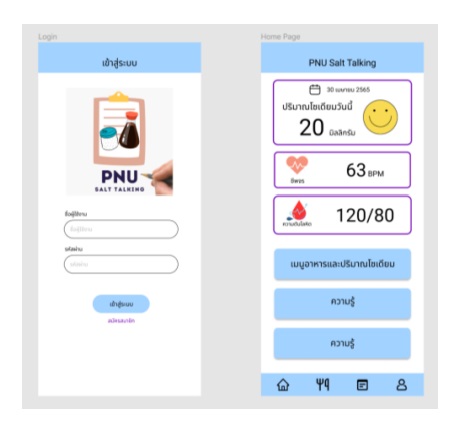Development of PNU SALT TALKING Application for Adults with Hypertension
Keywords:
Application, Low Sodium Consumption, Adult with HypertensionAbstract
This research and development study aimed to develop and evaluate the quality of a new PNU SALT TALKING application for adult with hypertension. The conceptual framework was based on the ADDIE five-steps model: 1) analysis, 2) design, 3) development, 4) implementation, and 5) evaluation. The quality of application was tested by three experts. Ten hypertensive adults also evaluated the tool using the Thai mobile health apps rating scale. Data analysis was performed, using descriptive statistic.
The results showed that the PNU Salt Talking application for adult with hypertension was effective to educate about sodium consumption in adults with hypertension. The application was divided in five main screens display and thirteen sub-screen displays, such as login or registration page, home page, food recording page, health assessment page, and profile (personal) page.
It has a good quality level for helping hypertensive adults and other people to modify their salt consumption behavior by themselves.
References
Ali, S. H., Luo, R., Li, Y., Liu, X., Tang, C., Zhang, P. (2019). Application of Mobile Health Technologies Aimed at Salt Reduction: Systematic Review. JMIR mHealth and uHealth, 7(4), e13250.
Aydin, A., & Gursoy, A. (2022). Mobile app for Breast Cancer Patients: Development Process Using the ADDIE models (Step 1). Research Square. Retrieved July 27, 2022 from https://assets.researchsquare.com/files/rs-1406933/v1/9362a1e3-4471-449f-af44-cd526643166f.pdf?c=1646239548.
Hongsanun, W., & Insuk, S. (2019). Development of the Thai Mobile Health Apps Rating Scale (THARS). Thai Journal of Pharmacy Practice, 11(1), 181-193. (in Thai).
Kaeodumkoeng, K. (2018). Health Literacy: Access Understand and Application. (2nd eds.). Nonthaburi: Amarin Book Center Company Limited. (in Thai).
Khunpol, S. (2022). The Design and Development of Media for Educating on Depression in the Elderly Ages at Pa Phayom District, Phatthalung Province. Journal of Mass Communication Technology, RMUTP, 7(1), 21-32. (in Thai).
Lerdmongkhonterakool, C., Bunyaphatkun, P. & Chitsomkasem, A. (2021). The Effects of Low Sodium,
DASH Dietary Pattern Education and Applying Theory of Planned Behavior on Blood Pressure Reduction in Hypertension Patients. Vajira Nursing Journal, 23(1), 31-45. (in Thai).
Maneetup, K. & Daenseekaew, S. (2017). Situation of Salt Intake among People with Hypertension in Thangkhuang Subdistrict, Waengnoi District, Khonkaen Province. Journal of Nursing and Health Care, 35(4: October - December), 140-149. (in Thai).
Nichols Hess, A. K. & Greer, K. (2016). Designing for Engagement: Using the ADDIE Model to Integrate High-Impact Practices Into an Online Information Literacy Course. Communications in Information Literacy, 10(2), 264-282.
Saedkong, P., Potchana, R., Wayo, W. & Klungklang, R. (2020). Effects of Using Hug Tai Application on Health Literacy among Patients with Diabetes Type 2, Hypertension, and Chronic Kidney Disease Stage 3 at Wat Nong Weang Pra-Aramluarg Parimary Care Unit in Khon Kaen. The Southern College Network Journal of Nursing and Public Health, 7(3), 195-206. (in Thai).
Samranbua, A. & Thamcharoentrakul, B. (2021). The Effects of Relieving Hypertension Diet Application on Health Belief among Patients with Hypertension. Thai Journal of Cardio-Thoracic Nursing, 32(1), 228-242. (in Thai).
Thai Hypertension Society. (2019). 2019 Thai Guidelines on the Treatment of Hypertension. Bangkok: Huanam Printing. (in Thai).
Thai Ministry of Public Health. (2019). Guidelines for the Operation of Low Sodium Diet in Hospital. Retrieved November 10, 2021 from http://www.thaincd.com/document/ file/download/paper-manual/Bookโรงพยาบาลเค็มน้อยอร่อย(3)ดี.pdf. (in Thai).
Thai Ministry of Public Health. (2021). Number of Hypertensive Patients in Narathiwat Province 2021. Retrieved July 20, 2022 from https://hdcservice.moph.go.th/hdc/reports/report_kpi. php?flag_kpi_level=9&flag_kpi_year=2022&source=pformated/format1.php&id=2e3813337b6b5377c2f68affe247d5f9. (in Thai).
Thajang, S., Panyathorn, K., Loonprom, N., Kensila, U., Khomhanpol, P., Jeenklun, K., et al. (2020). Effects of Using Media Application on Prevention of Complications for Knowledge on Patients with Hypertension. Udon Thani Rajabhat University Journal of Sciences and Technology, 8(2), 89-104. (in Thai).
Tongnuang, P., Hajichearong, R., Wayu, W., Bing, A., Hajisaaree, A., Kabae, A., et al. (2019). Preventive Behaviors for Hypertension among Adults in Narathiwat Province. Princess of Naradhiwas University Journal, 11(2), 49-61. (in Thai).
Wattanayon, S. (2014). Six Local Foods Local Eating to Asean. Princess of Naradhiwas University Journal, 1(1), 34 – 44. (in Thai).

Downloads
Published
Issue
Section
License
Copyright (c) 2022 The Southern College Network Journal of Nursing and Public Health

This work is licensed under a Creative Commons Attribution-NonCommercial-NoDerivatives 4.0 International License.
1. บทความหรือข้อคิดเห็นใด ๆ ที่ปรากฏในวารสารเครือข่าย วิทยาลัยพยาบาลและการสาธารณสุขภาคใต้ ที่เป็นวรรณกรรมของผู้เขียน บรรณาธิการหรือเครือข่ายวิทยาลัยพยาบาลและวิทยาลัยการสาธารณสุขภาคใต้ ไม่จำเป็นต้องเห็นด้วย
2. บทความที่ได้รับการตีพิมพ์ถือเป็นลิขสิทธิ์ของ วารสารเครือข่ายวิทยาลัยพยาบาลและการสาธารณสุขภาคใต้







